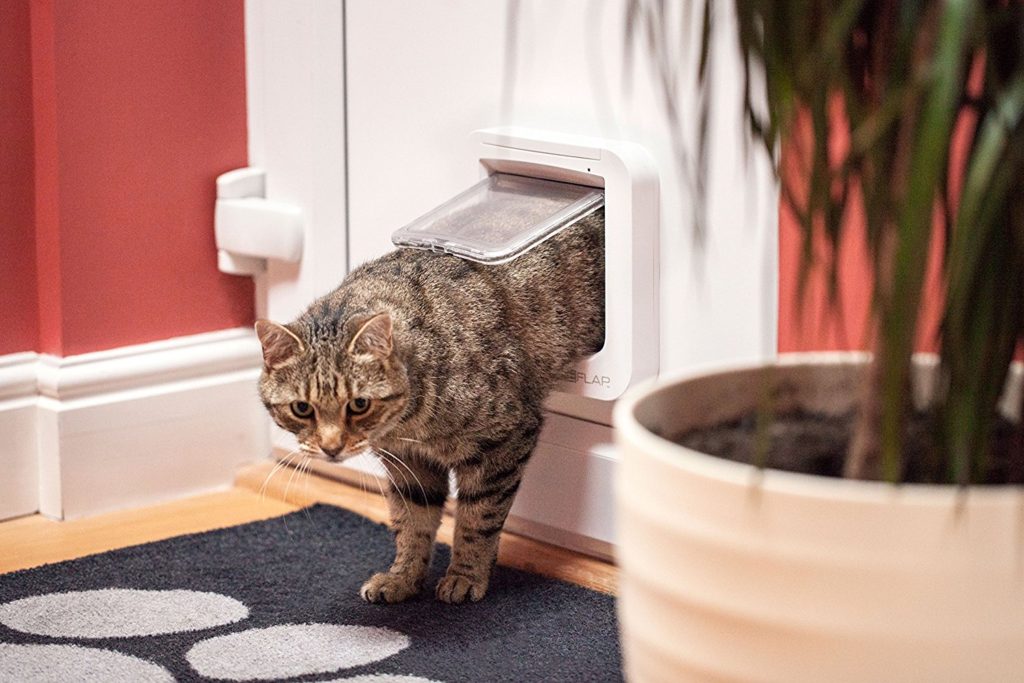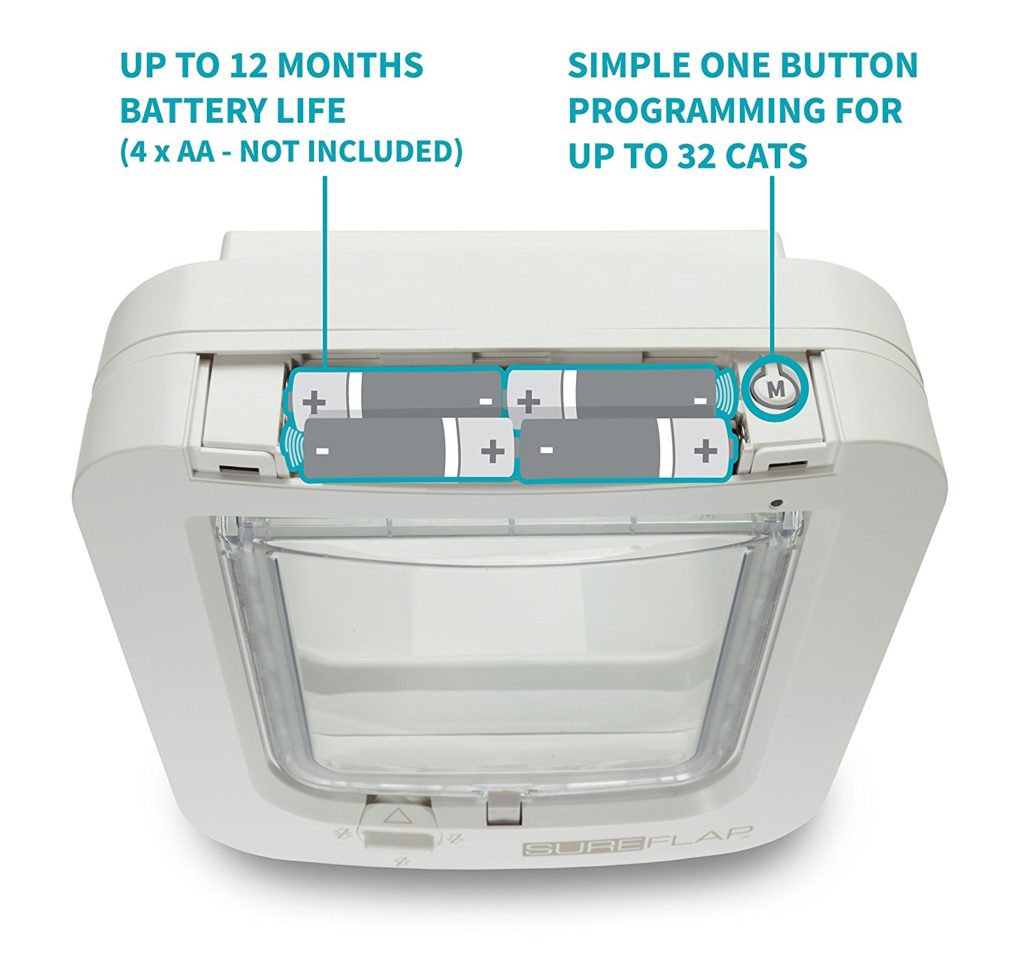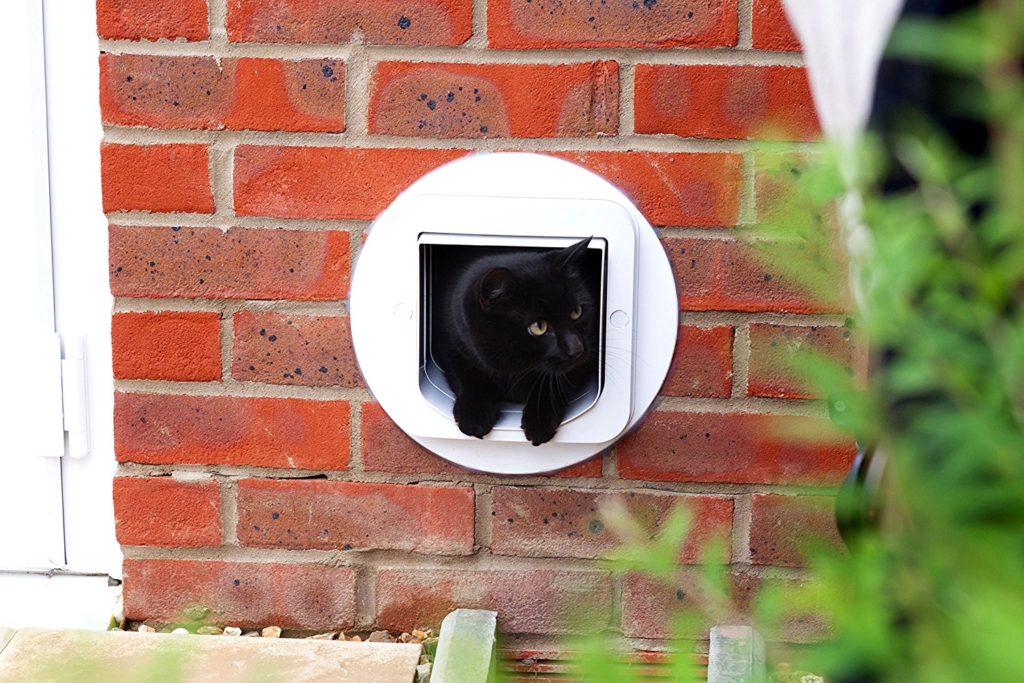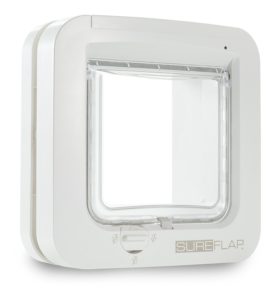SureFlap Microchip Cat Door Review
An automatic cat door is a great way of keeping unwanted visitors out, and your beloved pets inside your house. Or outside. Electronic cat flaps are programmable in any setting you might need. In this article, we dive into the specifics of the SureFlap Microchip for Cats.
What is the Sureflap Microchap Cat Door?
The SureFlap Microchip Cat Door is an automatic door for cats that employs a microchip implanted in the cat’s skin as a key. The door only unlocks when your microchipped cat tries to enter your house. Without a chip, intruders such as raccoons, the neighborhood cats, etc. are unable to enter your house through your cat flap.
This cat door has a strong central magnet, to keep the door from swinging in the wind, and to add more security and sealing power.
This particular system doesn’t require the cat to wear a collar with a tag to work, making it extra advantageous if your kitty does not like to wear collars.. or if your cat already lost several of them.
Some people do not like the thought of their cat getting microchipped. If you are one of them, SureFlap offers tags you can attach to your cat’s collar. You can buy these tags separately.
The system is suitable for single and large multi-cat households. You can program up to 32 unique cat ID’s in its memory.
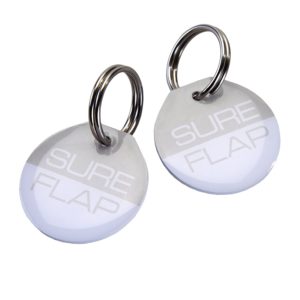
Selective Entry: Control Who Gets In And Out
The system of the SureFlap utilizes the principle of “selective entry,” which means it keeps undesired felines and other creatures from entering your home, but any pet can leave, regardless of wether they have a microchip implanted.
The cat flap features a 4-way manual locking setting that enables you to lock it with any combination of in/out your heart desires.
If your cat suffers bullying from a mean neighborhood cat or raccoons, or the other little critters come in to steal your cat;s food, the SureFlap is a great solution to put an end to all these unwanted behaviors.
The SureFlap cat door is suitable for small and medium sized cats.
Features of the SureFlap
The Cat door uses the RFID microchip technology as a key. It also features 4 methods of manual locking:
- 2-way,
- in-only,
- out-only
- locked.
The flap most likely works with your cat’s existing microchip. It is compatible with 9, 10 and 15 digit microchips. The only exclusions are 10-digit microchips, with codes beginning with 000, 010 and 020. You can program up to 32 microchips ids in the device’s memory.
No collar or tag required. Collars and tags can get lost or stolen. It runs on 4AA batteries (not included). Batteries last from 6-12 months with one cat, depending on the usage frequency. It has a light to indicate a low battery.
Selective entry – any cat can exit (with or without microchip).
It registers your cat’s microchip by pushing one button.
Sturdy and well-designed two-part device that you can install with ease in walls, doors, and windows.
This door fits into the gap left by most of the previous existing cat doors.
It also works with collar tags, available for purchase separately.
The magnet in the center prevents the door from flapping in the wind.
The tunnel design keeps intruder cats from pulling the door inwards.
3-year warranty provided by the manufacturer
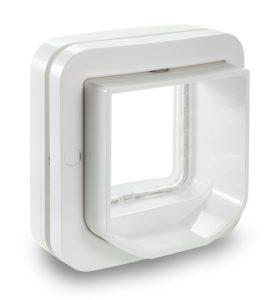
Unit Size and Dimensions
- Door Opening Dimensions: 5.59? (W) x 4.72? (H) / 142mm (W) x 120mm (H)
(This dimension is the narrowest section of the cat flap that your kitty will have to enter). - Hole Cutting Dimensions: 6.5? (W) x 6.73? (H) / 165mm (W) x 171mm (H)
(The amount of space needed to fit your cat door. The Installation Template can be used to cut the hole). - Exterior Frame Dimensions: 8.25? (W) x 8.25? (H) / 210mm (W) x 210mm (H)
- Tunnel Depth (outside): 2.75? / 70mm
- Tunnel Thickness: 0.18″ / 4.5mm
- Front Frame Depth (inside frame): 1.65″ / 42mm
- Item Weight: 2 lbs
Compatibility with Micro Chips
The SureFlap cat door works with the following micro chip codes:
–
- 15-digit microchips (FDXB, standard in Europe)
- 10-digit microchips (FDXA, frequently used in the USA). With exception of the 10-digit microchips of those starting with 000, 010 and 020.
- 9-digit microchips (known as Avid Secure/Encrypted Chip)
If you don’t remember your cat’s microchip number, do not despair.
If your cat has been previously microchipped in the past and you don’t remember the code number, you don’t need to remember it to program the door.
How to program the SureFlap:
- Push the program button
- Let your cat through the cat flap
- The scanner will read the microchip number
- Your cat’s microchip will be registered it in the SureFlap’s memory.
If you already have your cat microchipped with an incompatible microchip code, you might want to look into the newer and larger version: The SureFlap Microchip Pet Door. This door is suitable for larger cats and small pooches, and is compatible with all microchips – without exception.
If you haven’t previously microchipped your cat: We advise you to pass the microchip through the pet flap before you have the chip implanted in your cat’s skin. By the time your cat gets micro-chipped, you can be sure the chip is in working order and is already programmed in the entrance’s memory.
But if you do not like the idea of getting your kitty microchip implants, you can buy the optional RFID collar tag(s).
How Does This Unit Operate?
When the pre-approved microchipped cat comes close to the door and is about to enter it, a scanner placed in the tunnel scans the microchip, recognizes the ID and automatically unfastens a latch. This automatic action allows the kitty to push the door open with its head or nose, and subsequently enter your house.
The SureFlap microchip works with passive RFID technology. RFID is short for Radio Frequency Identification. RFID makes sure the chip implanted in your cats’ skin does not trigger the locking mechanism to open.
Rather, the microchip contains information waiting to be scanned and subsequently recognized by the scanner situated in the pet door’s frame.
The cat door’s interior structure has two types of sensors to scan the microchip with:
- a motion sensor
- a radio frequency sensor.
When your cat approaches the flap, first the motion sensor turns on and then activates the Radio Frequency scanner sensor to read the information on the microchip. Once the memory in the cat entrance identifies the chip ID, the system electronically opens the latch for your pet to push the door to get in.
After your cat enters the door, it shuts automatically by way of a strong magnet.
You can set the door with different lengths of time to close. Different closing times are especially useful when getting cats accustomed to automatic cat doors. Cats need to get used to the “click” sound when the scanner reads the microchip, allowing them to get through.
When training your felines to use the SureFlap, we advise you to set the closing speed to the slowest setting. The fastest setting for the flap to fasten after your pet has passed through is approximately 2 seconds.
See a video of the Sure Flap in action:
How does the 4-way locking system work?
2-Way.
Your cats can come indoors and go outdoors as they please. The SureFlap features the principle of selective entry. With selective entry, only micro chipped cats can enter the door, but any pet with or without microchip can leave.
Only-in.
Your cats can only get in, but they can’t get out. You can enable this option by manually turning a dial from the inside. This action locks the latch and keeps your cats in the house.
If one or more of your pets are outside and they are equipped with a microchip, your pet will be able to enter your home, but none of your pets can go outdoors. This option is useful to keep your cats in at night or to get them ready for veterinarian visits.
Only-out.
Any pet can exit the door, but none can get back in. You can manually set this option by turning a dial located on the flap.
This feature could be useful if you want to keep your cat outdoors when allergic visitors come over, the house cleaners do their job, or whatever reasons you might have to (temporary) keep your pets outside.
Locked.
The flap is shut tight. With this setting, no pet can enter or exit through the door. The setting as mentioned earlier is also helpful to keep your cats inside at night if you think your pet could outsmart the “Only In” mechanism. You also use Locked mode when you’re leaving on a trip with your cats.
It is important to mention that SureFlap cat door does not prevent cats without microchip from exiting the door. If you run a multiple cat household and you want to control which cat can enter and leave through the door, it is a better idea to get the SureFlap DualScan.
The 4-Way locking is not automatic or controlled by a timer. If you want your cat to be inside at specific times, you will need to set it by hand by shifting a control on the flap.
The newer version of the SureFlap Microchip Pet Door, designed for larger cats or small dogs, does come with a timer. You can set the timer change the door’s locking settings automatically at pre-programmed times.
What About the Batteries?
Battery Compartment
The batteries should last from 6 up to 12 months, depending on a few factors like:
how many cats use the door
how often you clean dirt and cat hair from it
how many unwanted “visitors” approach the cat flap during the day/night.
The company advises not to use rechargeable batteries because their performance is not 100% reliable. If you do decide to use rechargeable batteries, make sure to change them well before they run out.
If the batteries run out while you aren’t around, the entrance gets locked by default. Batteries going flat may leave your cat locked out or locked in. To help you avoid this terrible disaster, the SureFlap cat door has a battery life indicator, which is a small red led (on top of the door) that blinks when the batteries are about to run out.
Do make sure to check on the battery life indicator often.
How To Install This System?
The SureFlap microchip cat door consists of two parts that are being held together by screws. The depth of this tunnel is created with the two parts, and it’s adjustable. It is wholly adaptable to your doors’ measurement.
The tools you will need for installation of the SureFlap:
- Jig saw
- 1/4″ bit drill (6mm)
- Screwdriver
- Marker with felt tip
- Tape measure
- Spirit level
Wooden Doors
The installation of the SureFlap in wooden doors does not have the need for any adapters. You can install it by following the instructions on the YouTube video.
Metal Doors
To install the SureFlap in metal doors, you will need an adapter. The reason is that metal could interfere with the Radio Frequencies, thus stopping the scanner from scanning the microchip.
The adapter is especially a must when the metal has any steel components.
The SureFlap works exceptionally well on garage doors. The design of the SureFlap permits for a much tighter fit on thin metal garage doors than most other cat doors.
Glass Windows
When installing the door in glass windows, an adapter is required.
This adapter is circular with 11″ diameter. It is an excellent idea to let a glazier (glass professional) cut the opening for, instead of you or your handyman hubby.
Brick or Concrete Walls
One or possibly more SureFlap Tunnel Extenders may be required for wall installations, depending on the thickness of the wall. The original SureFlap Microchip cat door, without any Tunnel Extenders, can handle up to 2 inches in depth.
Installing the SureFlap in an Existing Opening
If you want to install the SureFlap onto a pre-existing opening, you will likely have a little bit of extra space on the width and height of the opening. You can use the “Cat Flap Mounting Adapter” to cover up the larger hole, without making the design look ugly.
The Good & The Bad
The Good
- Solid performance with RFID microchip technology
- Additional 4-way manual lock (in-only, out-only, in-and-out, locked)
- Easy to register the chip. Simply push the button and let the chip or cat with the chip implant pass through.
- Only the registered cats can enter the door with their unique microchip ID.
- No chance of other creatures wearing magnets or IR tags entering the door, unlike other types cat doors might.
- Your cats do not need to wear a collar tag.
- But if you want, this device can work with collar tags.
- Sturdy, rigid plastic flap.
- A clicking noise to act as a hindrance for wild animals following your pet.
- Durable weatherproof sealed door (although it may let in a little bit of a draft when not kept clean)
- Battery life indicator to notify you of due changes
- The long life of included batteries.
- Strong magnets allow fast closing of the door
- Strong magnet keeps the flap from blowing open by wind gusts.
- Well built, solidly made
- Easy to install
The Bad
- Selective entry means the door locks only in inwards direction, so it can be pulled open from the outside.
- Cheeky raccoons can open the door by pulling it open, especially on the setting that allows cats to leave and enter freely.
- The opening is on the small side. It is more fitting for small to medium sized felines and less for big cats (euphemism for overweight) or tall cats (4.72″ height).
- The clicking noise might be scary to your cat.
- Only battery powered, no backup power.
- The microchip has to be located directly on the back of the cat’s neck for the RFID sensor to scan the chip.
- The magnets make it a little bit laborious for your cats to shove the flap open.
- It does not work with 10-digit microchips beginning with 00, 010, 020.
- The mechanism requires the cat to stand still close to the door’s tunnel to get the chip scanned.
Tips On Using The System
To train your cat to get used to the “click” sound of the door unlocking, we recommend duct taping the “flap” open. So your cat can pass freely in the beginning. Even if your cats hear the “click,” they won’t be discouraged from pushing the door and going through it.
It will get accustomed to that sound more easily. Some cats take to the door quickly and use it straight away without any issues. Other cats can take days to weeks to get used to it (and a real skittish cat may take a month), but in the end, cats always end up utilizing the SureFlap cat door.
If you don’t want to get your cat microchipped, you can buy a chip and attach it to a cat´s collar. This way you can reuse the collar on other pets if you need to. You can buy new microchips if they get lost; they are rather affordable.
If the scanner of the flap does not scan your cats’ microchip, the chip may have migrated down the neck. We advise you to see your vet if you suspect this is the case.
If you want to keep your cat inside and you know your pet is very smart and strong-minded, it is advisable to use the setting “Locked” rather than “Only In.”
Conclusion
The SureFlap Microchip Cat Door is a remarkably great pet door that operates as advertised. The manufacturer improved the flap with the latest version. It is now much quieter when unfastening the lock. However, there is still a little clicking noise when unlocking; some cats might not like this at first.
But it is not a loud sound, and with a little usage, your pets get accustomed to it fast. The instructions explicitly explain how to train your cat to use the automatic cat door.
If your cat weighs less than 10 lbs, it will go through the flap without effort. Cats weighing over 10 pounds will probably have to do a little squeeze through the door to get inside your house.
For large sized cats, weighing in at 11+ lbs, there is a special larger version which you can view here: the SureFlap Pet Door suitable for larger cats and small dogs.
There are some previous editions of the SureFlap. The manufacturer guarantees that you will get the newest version when you purchase from Amazon.com.
We recommend the SureFlap Microchip Cat Door to anyone who has a micro-chipped cat or who will microchip their pets. It helps greatly in keeping out the neighbor’s cat, or any other wild animals that may be intruding your home. This door is suitable for small to medium sized cats.
We recommend it:
- If you want to replace your existing regular pet flap for a SureFlap
- To create feeding stations to separate your cats
- To separate litter box sites in different rooms to separate your pets
The cat door might not be suitable:
- To large breed cats, tall cats or overweight cats weighing more than 11 lbs; fat cats have to squeeze their body to go through.. or won’t fit through at all.
- If your cat has a 10-digit microchip that begins with 00, 010 or 020.
- If you require a 100% raccoon-proof solution. (The unit stops almost all raccoons, but a super tiny percentage of exceptionally bright raccoons may still outwit the SureFlap).
- For handicapped, disable or elderly cats with arthritis
- To be installed in real thick walls

